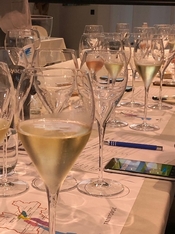
I’m a big fan of bubbles. I’m fortunate to have a fairly large selection of wine around my house, but if there’s one thing that always seems to be in short supply, it’s sparkling wine. Fizz from France, California, South Africa, Italy, Argentina, Australia, even England — it just seems to go quickly once it hits the door, and my wife’s even greater affinity for the stuff doesn’t do anything to slow the pace. That said, you can imagine my joy in learning that there’s a region in Italy that is claiming its rightful place of prominence on the international stage and making itself known and available beyond its own beautiful spot on earth.

Here’s a little background for starters. Although TrentoDOC (short for Trento Denomiazione di Origine Controllata — thanks for that, marketeers!) has been around since 1993, its declaration was made possible much further back, when Giulio Ferrari sourced fruit in the Dolomite foothills around Trento back in 1902, with the intent of making a sparkling wine that would rival those he found in Epernay. Today that hope is a reality, with the DOC counting 53 producers among its ranks and soon to add two more. TrentoDOC is a sub appellation in the northwest portion of the larger Trentino region, focused specifically on “Metodo Classico” sparkling wine made from Chardonnay, Pinot Noir, Pinot Blanc and Pinot Meunier, with most producers focusing on Chardonnay and Pinot Noir. A very small amount of Trentino’s overall production, about 8%, is dedicated to TrentoDOC, currently averaging over nine million bottles annually.
Many different styles are made, with most wineries making a non-vintage Brut and Brut Rosé, plus a reserve of some kind. There are currently several offerings of Brut Zero — wines that receive little or no dosage at disgorgement and coming in at sugar levels less than five grams per liter. The DOC specifies a minimum of 15 months on the yeast prior to disgorgement for multi vintage brut, 24 months for Millesemato, or vintage dated wine, and 36 months for a Riserva. Many producers age some of the wines much longer prior to release — some up to ten years.
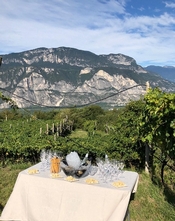
An important additional requirement of the DOC is that the fruit must be sourced from a specific elevation band, between 200 and 800 meters above sea level — that’s roughly between 650 and 2600 feet of elevation (hence, “Bubbles of the Mountain”) which gives the wines their distinctive regional character. The foothills topography of the area gives unlimited variety of sun exposures, allowing for planting to maximize sun exposure — bringing optimal ripeness — while maintaining the acidity allowed from wide growing season diurnal temperature swings not otherwise found at this 46-degree latitude. The result, if you will, is a combination of old-world structure and new world ripeness that occurs naturally, giving the wines both remarkable age-worthy character and fresh fruit deliciousness all at once. If you’re not already split screening and booking a flight to Venice as you read, hang on — there’s more.
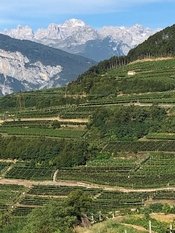
The region is stunningly beautiful, with sheer, glacially-cut rock faces rising out of the valley floor, fronted by foothills where viticulture has thrived for centuries, and still today, almost all the fruit for TrentoDOC wines is hand harvested. Most of the vineyards use a pergola system, where vine trunks are trained upward four to five feet and the cordon is angled over in one direction at an angle between 20 and 40 degrees, allowing for easy, walk under inspection, reach-through canopy control, and hand harvesting. The system also encourages airflow around the bunches, minimizing mold issues and taking full advantage of the temperature swings that define the region. It’s not all about the past, however — modern monitoring systems that track weather and wind are making it possible for growers to analyze data and make future planting and replanting decisions that sometimes involve using the Guyot vine training system. Large producers assist myriad small quantity growers with the science available — a synergistic meeting of historical knowledge and cutting-edge techniques that have an eye ever pointed toward the future.
Producers within the DOC are clearly committed to high quality and sustainability in practice from vineyard to glass. It’s interesting to note that the two largest wineries in the area focus a relatively small amount of their production on TrentoDOC, and that the Metodo Classico production method effectively creates a “winery within a winery” where a more boutique, high-quality product is possible. In fact, my highest scoring wine of the region comes from the largest winery, though you’d have to do a little research to connect the dots thanks to savvy marketing, which in this case isn’t evasive but rather reflective of practice. True Italian style, no?
The sustainable practice aspect also extends to business relationships between wineries and growers, who are paid for what they produce. Co-ops made up of as many as 1,600 small farmers are not only rewarded for quality, but are supported by the winery in times of replanting and less-than-perfect vintages, keeping the community well knit together and making the mountain farming life possible as family estates are divided into smaller and smaller lots. Though there are single vineyard wines being made, the DOC seems careful not to elevate particular sites by name, favoring proprietary names that show uniqueness, but serve to raise the reputation of the entire region.
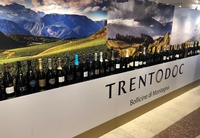
Of course, none of what you’ve read so far has much meaning if the end product isn’t worthy of your attention. I’m very happy to report that I did not taste a single wine that I didn’t find enjoyable, and I scored nearly all of the wines that I tasted 90 points or higher. A couple of them that are sold as far west as California — non-vintage bruts from Ferrari and Altemasi — represent great value priced in the twenties, and should be fairly easy to locate. Sparklers from some of the smaller producers may require a little searching, but are well worth the effort — particularity if you’re a big fan of the bubbles and want to get an overview of the regions’ distinctive profile.
Regarding the distinctiveness of this category, some producers speak of a “real ID card” that gets at what the scientific essence of what makes a TrentoDOC wine unique, namely, certain volatile compounds that appear in the wines that can only come from this region at these altitudes (differentiating them not only from their lower elevation neighbors from Franciacorta, but also from any other sparkling wine produced in the world). While I find the science interesting, I’m more interested in how this translates in the glass. What I discovered are wines of exceptional purity and clarity, with bright, fresh fruit flavors tending toward apple, pear and citrus, accented by stony minerality and minimal if any wood influence in the non-vintage wines. One finds more nuances and a layered character in the Millesemato and Riserva wines, with some bringing in light yeasty hints, and some displaying stone fruit and spice characteristics — even some occasional radish notes that add complexity.
If you’re now in full salivating mode, I’ll leave you with my notes on my favorite wine from my excursion. Watch for more tasting notes on beautiful TrentoDOC wines over the next several weeks here on
Wine Review Online.
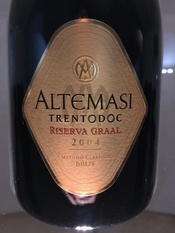 Altemasi TrentoDOC (Italy) Riserva “Graal” 2004 (in Magnum):
Altemasi TrentoDOC (Italy) Riserva “Graal” 2004 (in Magnum): A true world class sparkler, at fifteen years of age still showing youthful verve and power. Rich apple, pear and nut aromas flood the nose, with soft citrus zest and mild toast in the background. The palate directly translates the aromas into flavors, with racy acidity tempered by the larger format bottle and presenting great tension between creamy texture and freshening brightness. The finish is extremely persistent, with a walking on air lightness that keeps pushing flavor. Outstanding!
98